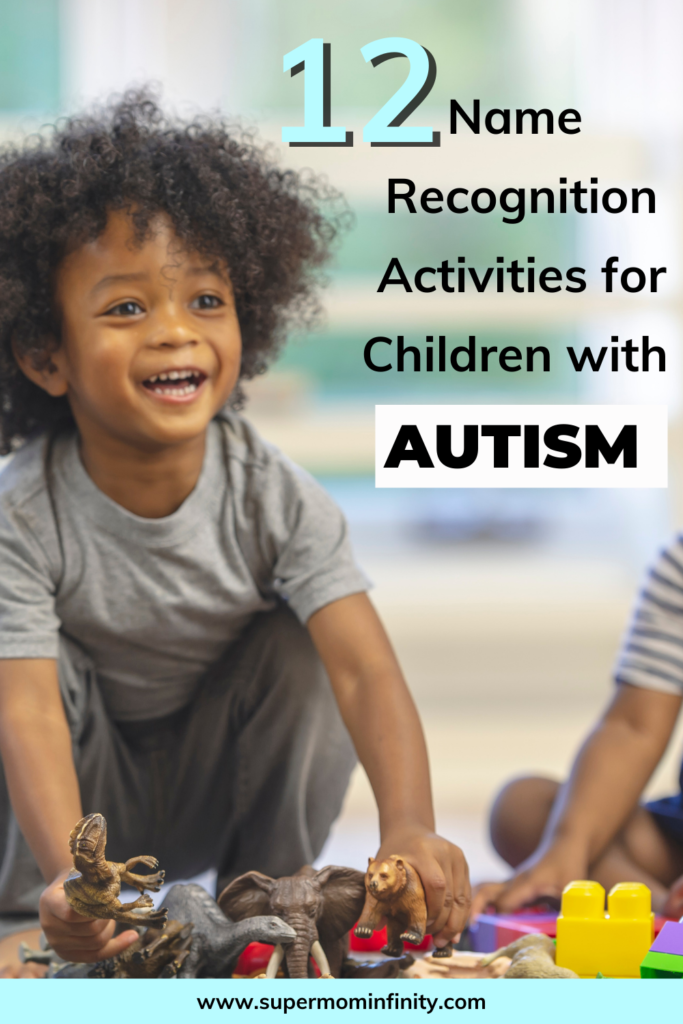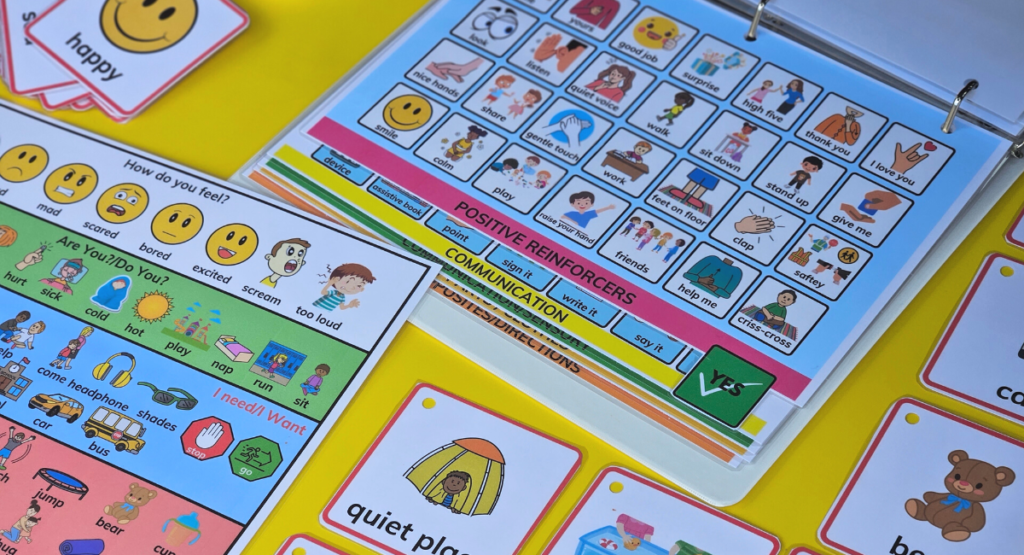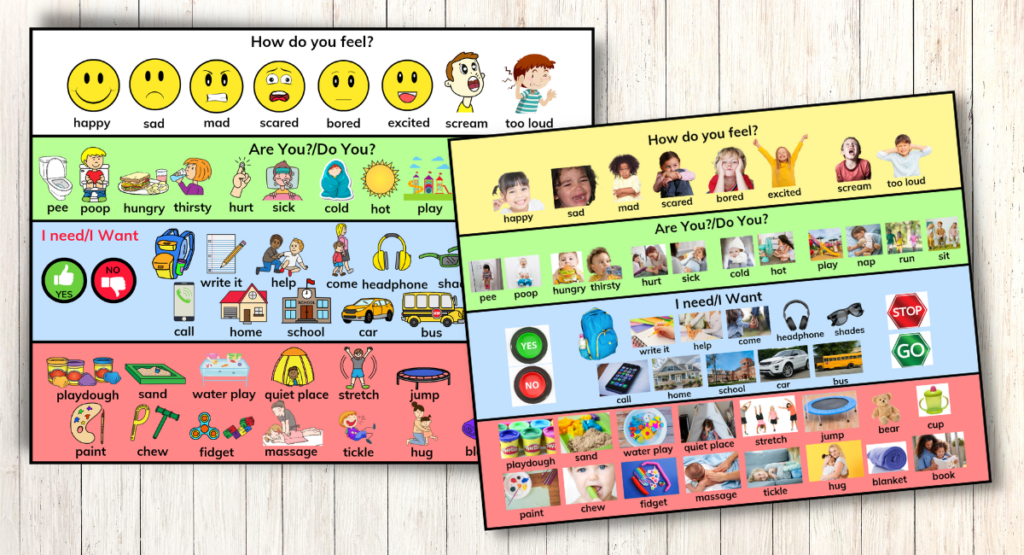
Name Recognition Activities for Toddlers with Autism
Toddlers with autism may have difficulties with social interaction and communication, which can make it challenging for them to recognize and remember names. However, there are several activities that can help toddlers with autism develop their name recognition skills and improve their socialization abilities.
Today you will learn common developmental challenges that may hinder your child’s ability to recognize and respond to his or her name. You will become knowledgeable with name recognition skills and 12 fun Name Recognition Activities you can use for your child!!!
SuperMomInfinity participates in the Amazon Services LLC Associates Program, an affiliate advertising program designed to provide a means for sites to earn advertising fees by advertising and linking to Amazon.com. Please read my Disclosure for more details.
Why is My Autistic Child Not Responding to His or Her Name?
Why is my autistic child not responding to his or her name is a question many parents of Autistic Children may ask. However, this question is very common. In reality, your child may not know his or her mane yet. Starting with basic eye contact and informing the child of his or her name is a great start to introducing the child to his or her name. You will say things like, Hi (the child’s name). Good morning (the child’s name). Point to yourself and say (I’m mommy). Point the child and say, you are (the child’s name). In a few weeks with repetition, your child will know his or her name!!!
Another reason your child may not be responding to his or her name is due to distractions. The child may simply be distracted and desire to continue what is more interesting to them at the present moment. So, this means you have to work your magic and become enthusiast and more entertaining than what is currently distracting your child. You can disguise your voice and say their name. This one usual gets the child’s attention very quickly and is pretty hilarious, but hey, it works!!! Always praise the child when they make eye contact with you. More factors to for children not responding to one’s name can contribute to developmental delays and hearing abilities.

My child is not answering to his/her name. What should I do?
If your child is not responding to his/her name, it can be concerning and may indicate a hearing or developmental issue. However, it’s important not to panic and to take some steps to try and understand the situation better. Here are some suggestions:
Observe your Child’s Behavior and Language Development
Does your child respond to other sounds or voices? Does he/she make eye contact when you speak or gesture? Does he/she communicate in other ways, such as pointing or gesturing?
Schedule a Hearing Screening
It’s important to rule out hearing loss as a possible cause. Your pediatrician can refer you to a specialist to conduct a hearing test.
Consult with a Developmental Specialist
If your child’s hearing is fine, but he/she is still not responding to his/her name, it may be helpful to consult with a developmental specialist to determine if there are other developmental issues at play.
Talk to your Child’s Pediatrician
Your child’s pediatrician can provide guidance on next steps and connect you with specialists or resources in your area.
Remember, every child develops at their own pace and it’s important not to compare your child’s development to others. With early intervention and support, your child has the best chance to reach their full potential.

12 Fun Name Recognition Activities to Teach Toddlers with Autism
Autistic children may struggle with recognizing their own name, which can make social interactions and learning more difficult. Here are 12 fun and easy activities to help improve name recognition for autistic children:
1. Call Your Child by Their Name
Consistently use your child’s name when addressing them. Eliminate nicknames and be sure to have other family members do the same. Your child will constantly and consistently hear their name being called by all members in the home/environment. This will help your child process and understand their individual name.
2. Show Their Name Daily
Use visual aids like magnetic letters, name tags or a laminated name on the wall to help your child associate their name with the written word. Your child will become family with the letters in his or her name and recognize their name as a whole.
3. Photos
Use photographs of your child and their loved ones to help them recognize their own face and name. Point to the child in the photo and state their name. Also, have to the child point themself out within the picture. This helps your child identify themselves when you announce their name.
4. Write the Child’s Name on All Papers
Write your child’s name on all of their belongings and school papers, including coloring sheets and activities.
5. Play Where is _____?
Play a game of “Where is ____?” State your child’s name and pretend you are looking got her. This game is super fun and promotes self-identity for your child. You can also hide a name tag or magnetic letters within their name around the house for them to find. Be sure to watch the video below for this Activity🤍. It was my daughter’s favorite!!!
6. Name Flashcards
Use name flashcards to help your child recognize their name in different fonts and sizes. Name flashcards will help your child identify their name amongst other names. Visual pictures for toddlers are easier to processes initial. Once your child master identifying themselves with their picture and name tag present, you can than eliminate the pictures and have your child point to their name amongst other family member names in the home/environment.
7. Playdough Mat
Use a playdough mat with the alphabet letters that’s within their name. Have your child play with one letter at a time. Laminate your playdough cards and have your child trace the letter with a dry erase marker. This is a fun letter recognition activity and also encourages fine motor development.
8. Alphabet School Bus
Hearing the letter sounds of their name with the Alphabet School Bus is a fun and exciting way your child can learn the letters and letter sounds within their name.
9. Letter Collage
Make a letter collage with different materials that start with each letter of your child’s name.
10. Name Collage
Create a name collage with, letters, photos, stickers and other decorations that represent your child’s favorite things.
11. Kinetic Sand Letter Hunt
Use Kinetic Sand to bury Alphabet Magnetic Letters or Foam Letters from your child’s name. Have your child dig through to find the letters in their name. Have your child announce the letter once your child finds the letter. Praise them always for practicing and participating.
12. Name Recognition Challenge
Challenge your child to recognize their name in different contexts, such as on a name tag or in a book. Celebrate their successes and encourage them to keep practicing.
Tips for Teaching Children with Autism Name Recognition
Remember to make these activities fun and engaging for the child, and to praise them for their efforts. With practice and patience, toddlers with autism can develop their name recognition skills and improve their socialization abilities.
Teaching toddlers with autism their name can be challenging, but it is a crucial step in their development. Here are some tips to make the process easier:
Repetition: Repetition is important when teaching children with autism. Repeat their name frequently, and use it in different contexts to help them learn to associate it with themselves.
Positive reinforcement: Positive reinforcement is a powerful tool when teaching children with autism. Praise the child when they respond to their name and use rewards such as stickers or small treats to encourage them.
Make it fun: Learning should be fun for children. Use games, songs, and other fun activities to teach the child their name. This will make the process more enjoyable for both the child and the parent.
Here is a video created by my daughter and I to inspire you with Name Recognition Activity Ideas!!!
Teaching Name Recognition to Autistic Children
Teaching name recognition to autistic toddlers is crucial for their overall development in several ways. It helps in the area of communication. Autistic children may find it difficult to communicate effectively, and knowing their own name is a positive step towards them being able to introduce themselves to others. This can help them with socialization and building relationships with others.
Learning name recognition can have a positive impact on their self-confidence. When they can recognize their own name, they feel a sense of ownership and belonging. This can help them feel more confident in their abilities and in their interactions with others.
Name recognition can also contribute to their self-esteem. Knowing their name is an accomplishment that can lead to a sense of pride and self-worth. This can help them develop a positive self-image and improve their overall mental health.
Learning name recognition can help autistic children with taking ownership of their belongings. When they can identify their own name, they are more likely to take responsibility for their belongings and keep track of them. This can lead to greater independence and self-sufficiency.
Remember, every child with autism is unique, and what works for one child may not work for another. Be patient and keep trying different methods until you find what works best for your child. With time and practice, your child will learn their name and many other important skills.
The Best Autism Communication Starter Kit for Special Needs Children
The Autism Communication Aid Starter Kit: A Must-Have Tool for Parents and Teachers The Autism…
Teaching Children with Autism How to Point: Step-by-Step Guide to Early Communication
Teaching Children with Autism How To POINT Teach Pointing Skills to your child as early…
The Best Autism Communication Board for Kids | 51 Communication Visuals
Best Communication Board for Kids at Home or in the Classroom The Best Autism Visual…



